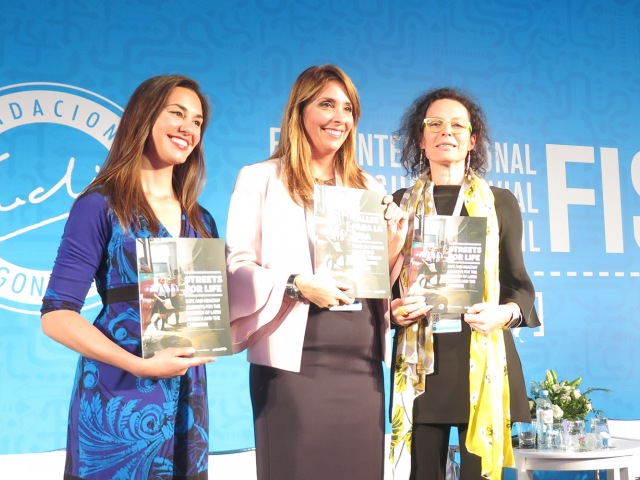
12/06/2018
Urgent action needed to combat leading killer of children over five in Latin America & the Caribbean
High rates of motorisation and inequality across the region combined with a widespread lack of protection on the roads are posing intolerable health burdens upon young people: in addition to the threat of road traffic injury, millions of children across Latin America live in areas that dangerously exceed air pollution limits where vehicle emissions are a significant contributor.
The report, Streets for Life: Safe and Healthy Journeys for the Children of Latin America and the Caribbean, is published jointly by UNICEF, Save the Children, Fundación Gonzalo Rodriguez and the FIA Foundation. These organizations are partners in the Child Health Initiative. It says children in low-income communities are most at risk of suffering from the combined health impacts of road traffic.
The report highlights that:
• Road traffic injury is a major health burden on the region’s children – the number one cause of death for those ages five to 14 and the second leading killer of adolescents 15 and over. Nearly 50 children are killed on the region’s roads every day.
• Children in low-income neighborhoods are particularly vulnerable and in many countries more children are killed as pedestrians than in vehicles. Basic protection is often absent: 88% of roads assessed across the region had no pedestrian crossings where traffic travels at speeds over 40km/h and 68% had no formal sidewalks.
• Motorcycle safety is also a growing concern in many countries across the region where young people and working families are often at risk. It must be addressed particularly through measures such as helmet regulation and enforcement.
• Especially in cities, where 80% of the population lives, dangerously high levels of toxic air pollution poses an ‘invisible’ threat to children. About 100 million children living in areas that exceed limits for PM 2.5 which penetrates deep into the lungs and causes permanent damage. Road traffic is a significant contributor to the region’s pollution threat.
Jamaican Olympic Champion Shelly-Ann Fraser-Pryce contributed to the report as part of campaigning with the Child Health Initiative for safe and healthy journeys to school. “Each day millions of children across Latin America and the Caribbean make that most important journey – the journey to school. Far too many are exposed to severe danger, facing traffic moving at life-threatening speed, with no footpaths or safe crossings. On top of this, many children in our cities are forced to breathe toxic air. Our kids are simply trying to go to school and we are failing in our duty to keep them safe and healthy,” said Fraser-Pryce who also serves as a UNICEF Goodwill Ambassador.
The daily danger faced by young people on the region’s roads represents a crisis for child rights, threatens their health and is a significant challenge for the delivery of the Sustainable Development Goals across Latin America and the Caribbean.
The report calls for action and funding from governments, donors and the leading agencies tasked with addressing child health to provide every single child in the region with a safe and healthy school journey and to protect children from the health burdens of road traffic.
The solutions to address this severe public health crisis for the region’s children exist and are readily available. The report presents evidence of effective policies that are saving lives on the roads in Latin America and the Caribbean. Authorities such as Mexico City have implemented the ‘Vision Zero for Youth’ approach which focuses on speed management to address one of the major risk factors leading to road traffic injuries and fatalities. The report shows that when urban policy and design prioritises people over cars, lives are saved. An important place to start is the school journey which must become the focus for collective efforts to implement ‘Vision Zero’ and similar approaches to protect children on the roads.
Such solutions must be integrated into a funded regional action plan addressing the burden of road traffic on youth, and it must feed into the Sustainable Development Goal Global Strategy for Women’s Children’s and Adolescent Health, the report argues.
María Cristina Perceval, Regional Director, UNICEF Latin America & the Caribbean said: “Road traffic deaths, disabilities, the suffering and hardship they cause children and their families are predictable and preventable. UNICEF calls on governments in the region to plan, implement and support the solutions required to prevent deaths, injuries and disabilities due to road crashes, so to ensure that every child, every day, everywhere has a safe journey to school.”
Saul Billingsley, FIA Foundation Executive Director said: “Our children are facing a public health epidemic resulting from road traffic. Put simply, the solutions work – there are strong examples across the region of life saving policies being implemented. Yet they are too rare and isolated. We need a scaled-up response, a regional action plan complemented by significant donor investment. Globally we are calling for a UN special summit on child and adolescent health to provide the urgency and leadership to save millions of lives between now and 2030. Latin America and the Caribbean must face up to the intolerable health burdens placed on children and as a region must play a major role in this.”
Nani Rodriguez, President Fundación Gonzalo Rodriguez said: “As a citizen of Uruguay and as a mother I am passionate about fighting this monster that takes the lives and threatens the health of millions of Latin American children. We can save lives on our roads but far too often our leaders are not taking action. In my country we have fought hard on issues such as mandatory use of child restraints and safe school transport. We must take this fight to the whole region and we call upon international agencies and the UN to support us.”
- Share: